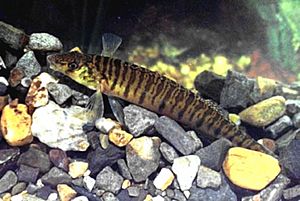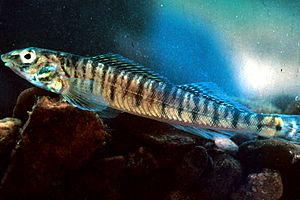Common logperch facts for kids
Quick facts for kids Common logperch |
|
|---|---|
 |
|
| Conservation status | |
| Scientific classification | |
| Synonyms | |
|
The common logperch (Percina caprodes) is a type of freshwater fish. It's a darter, which means it's part of the Percidae family. This family also includes perches and pikeperches.
Logperches have vertical stripes on their sides. They also have a mouth that points slightly downwards. This helps them find food on the bottom of rivers and lakes.
The common logperch is found in many places. It lives in clear streams and lakes with gravel. These fish can grow up to about 18 centimeters (7 inches) long. They usually live for about 3 years. Logperches are important for the snuffbox mussel (Epioblasma triquetra). They help these mussels reproduce.
Contents
About the Common Logperch Fish
The common logperch is a darter fish. It lives in many parts of North America. You can find it from the St. Lawrence River in Canada. It also lives in the Great Lakes area. Its range goes south through the Mississippi River to the Rio Grande. In 1953, logperch were also brought to California.
Logperch are bottom-dwelling fish. They lay their eggs without guarding them. After hatching, the baby fish float to calm water areas.
Where Do Logperch Live?
The common logperch lives in a very large area. Naturally, they live as far north as the St. Lawrence River in Quebec. They are found as far south as the Rio Grande in Texas and northern Mexico. To the west, they are common in the Mississippi River system. Their range goes east to freshwater areas near the Atlantic Ocean.
Today, logperch also live in California. They were released there in 1953. However, their natural living areas have shrunk. This is due to dams and new fish species. Some new fish, like the round goby, compete with them.
How Logperch Live and Eat
The common logperch lives on the bottom of rivers and lakes. It looks for food there. It likes clear, fast-moving water. This water usually has rocks or sand on the bottom. But you can find logperch in any warm water in their range.
They mostly eat small bugs that live on the bottom. They hunt by flipping over stones with their snout. Logperch are not picky eaters. They eat whatever food they can find. Small flies called chironomids are a big part of their diet. Other bugs like caddisflies and black flies are also important. What they eat can change by location and season.
Other fish that live on the bottom might compete with logperch for food. But the biggest threat is an invasive species. This is the round goby (Neogobius melanostomus). Round gobies are better at finding shelter. They are also more aggressive than logperch. Plus, round gobies reproduce faster. This means they can outcompete logperch.
Natural predators of logperch include larger fish. These are fish like walleye, bass, and pike.
Human Impact on Logperch
Humans can cause changes that harm logperch. These changes include adding too many predatory fish. Building dams on rivers also hurts them. Chemicals in water and erosion from human activities are also problems.
Adding too many predators can reduce logperch numbers. But other human activities also have a big impact.
Logperch Life Cycle
Common logperch become old enough to reproduce at about 2 years old. They lay eggs many times during the warmer months. This is usually in spring and summer. They lay small, sticky eggs that attach to rocks. Because of this, logperch like to lay eggs in shallow, rocky areas. These spots have plenty of oxygen.
When the eggs hatch, the tiny fish float to calm areas. These areas have more plankton for them to eat. Logperch eggs hatch earlier than most darter eggs.
Human activities can negatively affect their life cycle. Building dams and erosion around water areas are two examples.
Protecting Logperch Today
The common logperch is not currently an endangered species. So, there are no specific plans to manage them.
However, human changes are still harming logperch. Dams are one big problem. Dams can make the water below them have less oxygen. This is because the water comes from deep, low-oxygen parts of the reservoir. Low oxygen stresses young logperch. Their simple lungs need a lot of oxygen.
Dams also cause a lot of silt to build up on the river bottom. This happens because of changing water flow from power generation. Logperch hunt and lay eggs on rocky bottoms. Silt covers these rocks. This makes it harder for logperch to find food. It also makes it harder for them to lay eggs. Erosion from human activities also adds silt.
Using too many pesticides and fertilizers near rivers is also bad. These chemicals can kill water insects. They can also increase harmful nitrite levels.
The biggest threat might be the round goby. This invasive fish outcompetes the logperch. We can help logperch by managing farms better. This reduces chemicals in water. Stopping deforestation helps prevent erosion. Also, telling people about the dangers of releasing non-native species can help.
Taxonomy of the Logperch
The common logperch was first described in 1818. A French scientist named Constantine Samuel Rafinesque named it Sciaena caprodes. He found it in the Ohio River. Later, another scientist, Samuel Stehman Haldeman, created the genus Percina. He described Perca (Percina) nebulosa, which is another name for P. caprodes. This means the common logperch is the main example species for the Percina group of fish.
Images for kids
See also
 In Spanish: Percina caprodes para niños
In Spanish: Percina caprodes para niños





